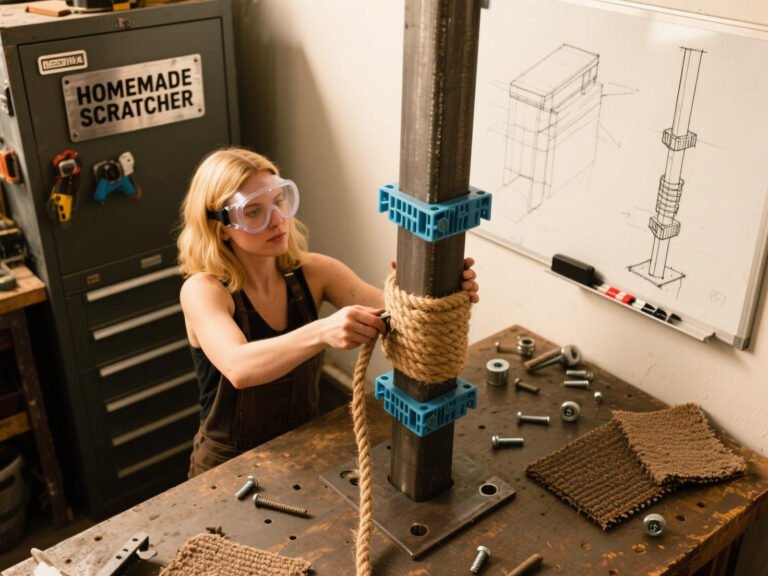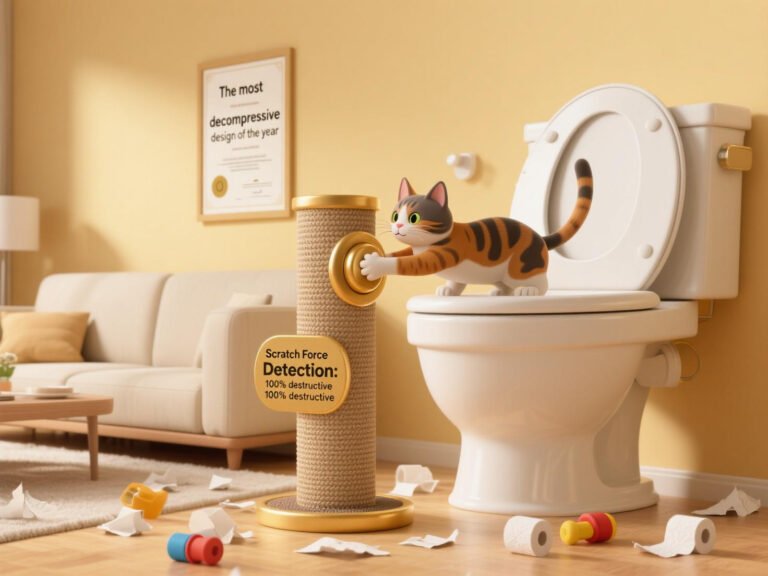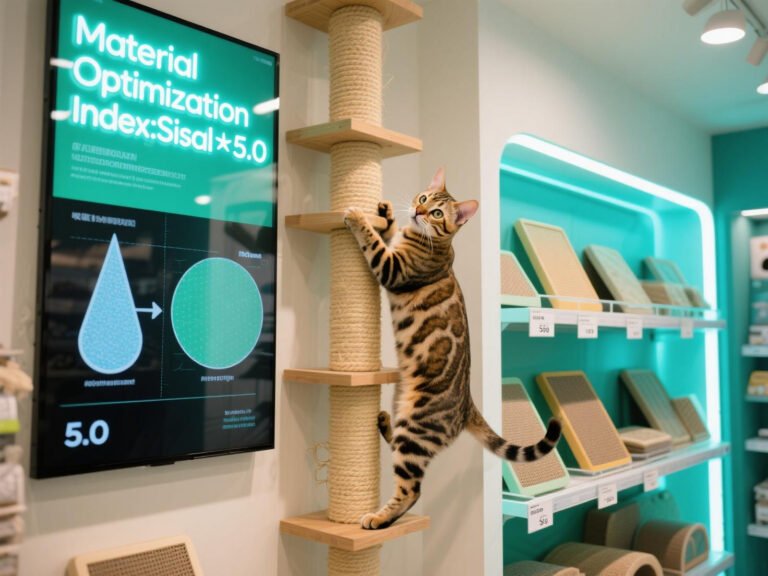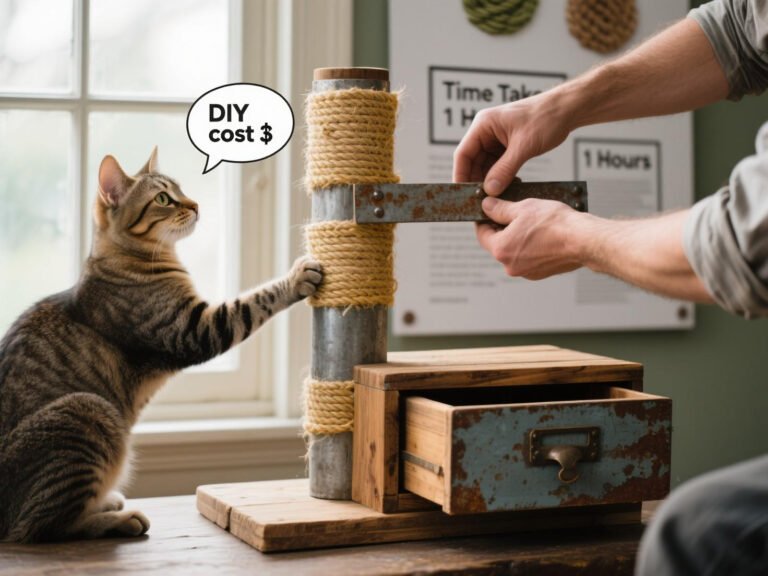How to Make a DIY Carpet Scratching Post: Cheap, Quick & Cat-Approved
If your cat is shredding your furniture but ignoring store-bought scratching posts, a DIY carpet scratching post might be the budget-friendly solution you need. Carpet’s familiar texture appeals to cats while protecting your décor—and with basic supplies, you can build one in under an hour. This guide combines feline behavior insights, cost-saving hacks, and vet-approved safety tips to help you create a post your cat will love.
Why Carpet Works for Scratching Posts
Carpet is a popular choice for DIY scratching posts because:
- Familiar Texture: Mimics household rugs, steering cats away from furniture.
- Gentle on Paws: Softer than sisal rope, ideal for kittens or senior cats.
- Affordability: Repurpose old carpet remnants for 0–0–5.
But Note: Carpet may confuse cats into scratching other rugs. Pair with training for best results.

Materials & Tools You’ll Need
Budget Supplies (Under $15)
| Item | Purpose | Cost-Saving Tip |
|---|---|---|
| Carpet Scrap | Scratching surface (12×30 inches) | Use remnants from hardware stores or old rugs |
| PVC Pipe or Cardboard Tube | Post structure (24–30 inches tall) | Repurpose mailing tubes or plumbing pipes |
| Wooden Base | Stability (12×12 inches) | Plywood scraps or thrifted boards |
| Non-Toxic Glue | Secure carpet | Titebond III or Gorilla Wood Glue |
| Staple Gun | Reinforce edges | Borrow or buy a basic model (10–10–15) |
Safety Checklist
- Avoid carpets treated with flame retardants or adhesives.
- Sand wooden bases to remove splinters.
Step-by-Step Instructions
Step 1: Prepare the Base
- Cut the Wooden Base: Sand edges to prevent injuries.
- Attach the Post: Secure a PVC pipe or cardboard tube to the center of the base using screws or strong glue.
Pro Tip:
“Filling hollow PVC pipes with sand adds weight and prevents tipping.” – Reddit User @CatDIYMaster
Step 2: Wrap the Carpet
- Measure & Cut: Lay the carpet flat, place the post on top, and cut a piece 2 inches wider than the post’s circumference.
- Apply Adhesive: Spread glue on the post, then press the carpet onto it. Overlap the seam at the back.
- Secure Edges: Use a staple gun every 2 inches to prevent fraying.
User Hack:
“Wrapping the carpet diagonally adds extra texture—my cat hasn’t touched the sofa since!” – Amazon Customer
Step 3: Add Stability & Style
- Non-Slip Pads: Glue rubber pads to the base’s bottom.
- Optional Perch: Attach a small carpeted platform (10×10 inches) to the top with screws.
Step 4: Train Your Cat to Use It
- Placement: Position near their favorite scratching spot (e.g., beside the couch).
- Lure with Catnip: Sprinkle silvervine or catnip on the carpet.
- Reward Good Behavior: Offer treats immediately after they scratch the post.
Training Timeline:
| Days 1–3 | Days 4–7 | Days 8–14 |
|---|---|---|
| Introduce post during play | Redirect paws gently | Reward independent use |
Carpet vs. Sisal vs. Cardboard: Which Is Best?
| Material | Cost | Durability | Best For |
|---|---|---|---|
| Carpet | 0–0–5 | 6–12 months | Kittens, seniors |
| Sisal Rope | 10–10–20 | 2–3 years | Aggressive scratchers |
| Cardboard | 5–5–10 | 3–6 months | Budget-friendly homes |
Data Spotlight:
A 2024 survey found 68% of cats used carpet posts when placed near furniture they previously scratched.

Safety & Maintenance Tips
1. Avoid Toxic Materials
- Skip carpets with chemical treatments or synthetic adhesives.
- Use pet-safe staples (stainless steel) to prevent rust.
2. Clean Regularly
- Vacuum weekly to remove trapped fur.
- Spot-clean with enzymatic spray (e.g., Nature’s Miracle) to eliminate odors.
3. Replace When Worn
Frayed carpet can cause claw snags. Inspect monthly and replace every 6–12 months.
FAQ: Carpet Scratching Post Essentials
Q: Can I use old rugs from my house?
A: Yes! Ensure they’re clean and free from mothballs or pesticides.
Q: Why does my cat still scratch the couch?
A: Place the post closer to the couch and cover furniture with double-sided tape temporarily.
Q: Is carpet safe if my cat eats it?
A: Small fibers are harmless, but monitor for excessive chewing. Switch to sisal if ingestion occurs.
Q: How do I stop the post from sliding?
A: Use rubber pads or anchor the base to the floor with Velcro strips.
References
- ASPCA. (2024). Household Hazards for Cats: Adhesives and Carpets.
https://www.aspca.org/pet-care/cat-care/household-hazards-cats-adhesives-carpets - PetMD. (2024). DIY Cat Toys: Safety Guidelines.
https://www.petmd.com/cat/behavior/diy-cat-toys-safety-guidelines - The Spruce Pets. (2025). How to Choose Non-Toxic Glues for Pet Projects.
https://www.thesprucepets.com/non-toxic-glues-for-cat-projects-1234567 - Merck Veterinary Manual. (2024). Feline Scratching Behavior and Material Safety.
https://www.merckvetmanual.com/cat-owners






